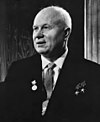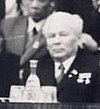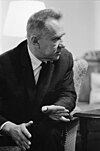List of leaders of the Soviet Union
Template:Infobox former communist states Under the 1977 Soviet Constitution of the Union of Soviet Socialist Republics (USSR), the Chairman of the Council of Ministers of the USSR was the head of government[1] and the Chairman of the Presidium of the Supreme Soviet was the head of state.[2] The office of the Chairman of the Council of Ministers was the equivalent to a First World Prime Minister,[1] while the office of the Chairman of the Presidium was equivalent to the office of the President.[2] In the Soviet Union's seventy-year history there was no official leader of the Soviet Union offices but a Soviet leader usually led the country through the office of the Premier and/or the office of the General Secretary of the Communist Party of the Soviet Union (CPSU). Following Joseph Stalin's consolidation of power in the 1920s[3] the post of the General Secretary of the Central Committee of the Communist Party became synonymous with 'Leader of the Soviet Union'[4] due to the fact that the post controlled both the CPSU and the Soviet government.[3] The post of the General Secretary was abolished under Stalin and later re-established by Nikita Khrushchev under the name of First Secretary; in 1966 Leonid Brezhnev reverted the office title to its former name. Being the head of the communist party,[5] the office of the General Secretary was the highest in the Soviet Union until 1990.[6] The post of General Secretary lacked clear guidelines of succession, so after the death or removal of a Soviet leader, the successor usually needed the support of the Politburo, the Central Committee, another government or party apparatus to both take and stay in power. The President of the Soviet Union, an office created in March 1990, replaced the General Secretary as the highest Soviet political office.[7]
Contemporaneously to establishment of the office of the President, representatives of the Congress of People's Deputies voted to remove Article 6 from the Soviet constitution which stated that the Soviet Union was a one-party state controlled by the Communist Party which, in turn, played the leading role in society. This vote weakened the Party and its hegemony over the Soviet Union and its people.[8] Upon death, resignation, or removal from office of an incumbent President, the Vice President of the Soviet Union would assume the office, though the Soviet Union collapsed before this was actually tested.[9] After the failed August Coup the Vice President was replaced by an elected member of the State Council of the Soviet Union.[10]
Summary
| Politics of the Soviet Union |
|---|
 |
|
|
Vladimir Lenin became the Chairman of the Council of People's Commissars of the USSR on 30 December 1922 by the Congress of Soviets.[11] His health, at the age of 53, declined from effects of two bullet wounds, later aggravated by three strokes which culminated with his death in 1924.[12] Regardless of his health in his last days, Lenin was already losing much of his power to Stalin.[13] Stalin's early policies pushed for rapid industrialisation, nationalisation of private industry[14] and the collectivisation of private plots created under Lenin's New Economic Policy.[15] Stalin, as head of the Political Bureau (Politburo), consolidated near-absolute power in the 1930s after the Great Purge, a series of campaigns of political repression and persecution.[16] Nazi German troops invaded the Soviet Union in June 1941,[17] but were repulsed by the Soviets in December. On Stalin's orders, the USSR launched a counter-attack on Nazi Germany.[18] Stalin died in March 1953,[19] his death triggered a power struggle in which Khrushchev after several years emerged victorious against Georgy Malenkov.[20]
Khrushchev denounced Stalin on two occasions: in 1956 and 1962. His policy of de-Stalinisation earned him many enemies within the party, especially from old Stalinist appointees. Many saw this approach as destructive and destabilising. A group known as Anti-Party Group tried, but failed, to oust Khrushchev from office in 1957.[21] As Khrushchev grew older, his erratic behavior became worse, usually taking decisions without discussing or confirming them with the Politburo.[22] Leonid Brezhnev, a close companion of Khrushchev, was elected First Secretary the same day of Khrushchev's removal from power; Alexei Kosygin became the new Premier and Anastas Mikoyan kept his office as Chairman of the Presidium of the Supreme Soviet. In 1965, on the orders of the Politburo, Mikoyan was forced to retire; Nikolai Podgorny took over the office of Chairman of the Presidium.[23] The USSR in the post-Khrushchev 1960s was governed by the All-People's Government.[24] Henry A. Kissinger, the American National Security Advisor, falsely believed that Kosygin was the 'Leader of the Soviet Union' and that he was at the helm of 'Soviet foreign policy' because he represented the Soviet Union at the 1967 Glassboro Summit Conference.[25] The "Era of Stagnation", a derogatory term coined by Mikhail Gorbachev, was a period marked by low socio-economic efficiency in the country and a gerontocracy ruling the country.[26] Yuri Andropov succeeded Brezhnev in his post as General Secretary in 1982. In 1983 Andropov was hospitalised, and rarely met up at work to chair the politburo meetings due to his declining health. Nikolai Tikhonov usually chaired the meetings in his place.[27] Following Andropov's death, an even older leader, Konstantin Chernenko was elected to the General Secretariat. His rule lasted for little more than a year.[28]
Gorbachev was elected to the General Secretariat by the Politburo on 11 March 1985.[29] By the mid-to-late 1980s Gorbachev had launched the policies of perestroika (literally meaning "reconstruction", but varies) and glasnost ("openness" and "transparency").[30] The dismantling of the principal defining features of communism in 1988 and 1989 in the Soviet Union led to the unintended consequence of breaking-up the Soviet state into 15 successor states after the failed August Coup of 1991 led by Gennady Yanayev.[31]
List of leaders
The following list includes only those persons who were able to gather enough support from the Communist Party of the Soviet Union (CPSU) and the government, or one of these to rule the Soviet Union.
| Name (birth–death) |
Portrait | Term of office | Congress | Notes |
|---|---|---|---|---|
| Vladimir Lenin (1870–1924)[32] |

|
30 December 1922[32] – 21 January 1924[13] | 1st—12th Congress | Chairman of the Council of People's Commissars and informal leader of the Bolsheviks since their inception.[32] Was leader of the Russian Soviet Federative Socialist Republic (RSFSR) from 1917 and leader of the Union of Soviet Socialist Republics (USSR) from 1922 until his death.[33] |
| Joseph Stalin (1878–1953)[13] |
File:StalinPortrait.jpg | 21 January 1924[13] – 5 March 1953[34] | 13th—19th Congress | General Secretary from 3 April 1922 until the office of General Secretary was abolished in October 1952.[35] Stalin served as Premier from 6 May 1941 until his death on 5 March 1953.[34] He also held the post of the Minister of Defense of the USSR from 19 July 1941 until 3 March 1947 and Chairman of the State Defense Committee during the Great Patriotic War[36] and became the only officer to hold the office of People's Commissariat of Nationalities from 1921–1923.[37] |
| Georgy Malenkov (1902–1988)[38] |

|
5 March 1953[39][38] – 8 February 1955[40] | — | Was the leading figure of the Secretariat of the Communist Party of the Soviet Union, but was later forced to resign. From Stalin's death[41] to February 1955 Malenkov, through the office of Premier, was locked in a power struggle against Khrushchev.[42] |
| Nikita Khrushchev (1894–1971)[43] |

|
27 March 1955[43] – 14 October 1964[44] | 20th—22nd Congress | Served as the First Secretary of the Central Committee of the Communist Party of Soviet Union and Chairman of the Council of Ministers of the USSR from 27 March 1958 to 14 October 1964. Khrushchev was removed from power after a trip to Scandinavia by Leonid Brezhnev and his supporters.[45] |
| Leonid Brezhnev (1906–1982)[44] |

|
14 October 1964[44] – 10 November 1982[46] | 23rd—26th Congress | Served as First Secretary of the Central Committee of the Communist Party, was later renamed General Secretary,[22] and later Chairman of the Presidium.[23] |
| Yuri Andropov (1914–1984)[47] |

|
12 November 1982[47] – 9 February 1984[48] | — | General Secretary of the Central Committee of the Communist Party[25] and Chairman of the Presidium from 16 June 1983 until 9 February 1984.[49] |
| Konstantin Chernenko (1911–1985)[50] |

|
13 February 1984[50] – 10 March 1985[22] | — | General Secretary of the Central Committee of the Communist Party[51] and Chairman of the Presidium from 11 April 1984 to 10 March 1985.[52] |
| Mikhail Gorbachev (1931–present)[22] |

|
11 March 1985[22] – 25 December 1991[53] | 27th—28th Congress | Served as General Secretary from 11 March 1985,[52] and resigned on 24 August 1991,[54] Chairman of the Presidium of the Supreme Soviet from 1 October[51] 1988 until the office was renamed to the Chairman of the Supreme Soviet on 25 May 1989 to 15 March 1990[52] and President of the Soviet Union from 15 March 1990[55] to 25 December 1991.[56] The day following Gorbachev's resignation as President, the Soviet Union was formally dissolved.[53] |
List of troikas
On two occasions, between Stalin's death and Nikita Khrushchev's rise to power, and between Khrushchev's fall and Leonid Brezhnev's consolidation of power, a collective leadership known as the Troika (meaning "threesome")[57] governed the country, with no single individual holding dictatoral power alone.[39][23]
| Members (birth–death) |
Tenure | Notes | |||
|---|---|---|---|---|---|
| First Troika | File:MarshalBeria.jpg | 
|

|
13 March 1953[39] – 26 June 1953[58] | This Troika consisted of Georgy Malenkov, Lavrentiy Beria, and Vyacheslav Molotov[59] and ended when Malenkov and Molotov deceived Beria.[43] |
| Lavrentiy Beria (1899–1953)[39] |
Georgy Malenkov (1902–1988)[39] |
Vyacheslav Molotov (1890–1986)[39] | |||
| Second Troika | File:1977 CPA 4774(Cutted).jpg | 
|

|
14 October 1964[44] – 16 June 1977[23] | The Troika consisted of Leonid Brezhnev as First Secretary, Alexei Kosygin as Premier and Anastas Mikoyan as Chairman of the Presidium of the Supreme Soviet of the USSR. Mikoyan retired from politics in 1965 and was replaced by Nikolai Podgorny. During Brezhnev's gradual consolidation of power, the Troika was dissolved when Brezhnev became the Chairman of the Presidium of the Supreme Soviet in 1977.[23] |
| Leonid Brezhnev (1904–1982)[44] |
Alexei Kosygin (1906–1980)[44] |
Nikolai Podgorny (1903–1983)[44] | |||
See also
- Index of Soviet Union-related articles
- List of heads of state of the Soviet Union
- List of Premiers of the Soviet Union
- List of presidents of the Russian Federation
References
- Notes
- ^ a b Armstrong 1986, p. 169.
- ^ a b Armstrong 1986, p. 165.
- ^ a b Armstrong 1986, p. 98.
- ^ Armstrong 1986, p. 93.
- ^ Ginsburgs, George; Ajani, Gianmaria; van den Berg, Gerard Peter (1989). Soviet Administrative Law: Theory and Policy. Brill Publishers. p. 500. ISBN 0792302885.
{{cite book}}: CS1 maint: multiple names: authors list (link) - ^ Armstrong 1989, p. 22.
- ^ Brown 1996, p. 195.
- ^ Brown 1996, p. 196.
- ^ Brown 1996, p. 275.
- ^ Government of the USSR: Gorbachev, Mikhail (21 March 1972). "УКАЗ: ПОЛОЖЕНИЕ О МИНИСТЕРСТВЕ ЮСТИЦИИ СССР" (in Russian). sssr.su. Retrieved 15 November 1991.
{{cite web}}: Check date values in:|accessdate=(help); Unknown parameter|trans_title=ignored (|trans-title=suggested) (help) - ^ Lenin, Vladimir (1920). Collected Works. Vol. 31. p. 516.
- ^ Clark, William (1988). Lenin: The Man Behind the Mask. Faber and Faber. p. 373. ISBN 0571139043.
- ^ a b c d Brown 2009, p. 59.
- ^ Brown 2009, p. 62.
- ^ Brown 2009, p. 63.
- ^ Brown 2009, p. 72.
- ^ Brown 2009, p. 90.
- ^ Brown 2009, p. 148.
- ^ Brown 2009, p. 194.
- ^ Brown 2009, pp. 231–33.
- ^ Brown 2009, p. 246.
- ^ a b c d e Service 2009, p. 378.
- ^ a b c d e Brown 2009, p. 402.
- ^ Bacon and Sandle 2002, p. 13.
- ^ a b Brown 2009, p. 403.
- ^ Brown 2009, p. 398.
- ^ Zemtsov, Ilya (1989). Chernenko: the last Bolshevik : the Soviet Union on the eve of Perestroika. Transaction Publishers. p. 146. ISBN 0887382606.
- ^ Brown 2009, p. 481.
- ^ Brown 2009, p. 487.
- ^ Brown 2009, p. 489.
- ^ Brown 2009, p. 503.
- ^ a b c Brown 2009, p. 53.
- ^ Sakwa, Richard (1999). The Rise and Fall of the Soviet Union, 1917–1991. Routledge. pp. 140–143. ISBN 9780415122900.
- ^ a b Service 2009, p. 323.
- ^ Service 2009, pp. 231–32.
- ^ Green, William C.; Reeves, W. Robert (1993). The Soviet Military Encyclopedia: P–Z. University of Michigan: Westview Press. p. 196. ISBN 0813314321.
{{cite book}}: CS1 maint: multiple names: authors list (link) - ^ Service, Robert (2005). Stalin: A Biography. Harvard University Press. p. 154. ISBN 0674016971.
- ^ a b Service 2009, p. 331.
- ^ a b c d e f Service 2009, p. 332.
- ^ J. Duiker, William; J. Spielvogel, Jackson (2006). The Essential World History. Cengage Learning. p. 572. ISBN 0495097292.
{{cite book}}: CS1 maint: multiple names: authors list (link) - ^ A. Cook, Bernard (2001). Europe since 1945: an encyclopedia, Volum 1. Taylor & Francis. p. 163. ISBN 0815340575.
- ^ L. Hill, Kenneth (1993). Cold War chronology: Soviet–American relations, 1945–1991. University of Michigan: Congressional Quarterly. p. 61. ISBN 0871879212.
- ^ a b c Taubman 2003, p. 258.
- ^ a b c d e f g Service 2009, p. 377.
- ^ Service 2009, p. 376.
- ^ Service 2009, p. 426.
- ^ a b Service 2009, p. 428.
- ^ Service 2009, p. 433.
- ^ Paxton 2004, p. 234.
- ^ a b Service 2009, p. 434.
- ^ a b Europa Publications Limited (2004). Eastern Europe, Russia and Central Asia. Routledge. p. 302. ISBN 1857431871.
- ^ a b c Paxton 2004, p. 235.
- ^ a b Gorbachev, Mikhail (1996). Memoirs. University of Michigan: Doubleday. p. 711. ISBN 0385480199.
- ^ Service 2009, p. 503.
- ^ Paxton 2004, p. 236.
- ^ Paxton 2004, p. 237.
- ^ Tinggaard Svendsen, Gert; Haase Svendsen, Gunnar Lind (2009). Handbook of Social Capital: The Troika of Sociology, Political Science and Economics. Edward Elgar Publishing. p. 460. ISBN 1845423232.
{{cite book}}: CS1 maint: multiple names: authors list (link) - ^ Andrew, Christopher; Gordievsky, Oleg (1990). KGB: The Inside Story. HarperCollins Publishers. pp. 423–24. ISBN 0-06-016605-3.
{{cite book}}: CS1 maint: multiple names: authors list (link) - ^ Marlowe, Lynn Elizabeth (2005). GED Social Studies: The Best Study Series for GED. Research and Education Association. p. 140. ISBN 0738601276.
- Bibliography
- Armstrong, John Alexander (1986). Ideology, Politics, and Government in the Soviet Union: An Introduction. University Press of America. ISBN 0819154059.
- Brown, Archie (1996). The Gorbachev Factor. Oxford University Press. ISBN 978-1-845-95076-5.
{{cite book}}: Check|isbn=value: checksum (help) - Taubman, William (2003). Khrushchev: The Man and His Era. W.W. Norton & Company. ISBN 0393324842.
- Sandle, Mark; Bacon, Edwin (2002). Brezhnev Reconsidered. Palgrave Macmillan. ISBN 033379463X.
{{cite book}}: CS1 maint: multiple names: authors list (link) - Paxton, John (2004). Leaders of Russia and the Soviet Union: from the Romanov dynasty to Vladimir Putin. CRC Press. ISBN 1579581323.
- Service, Robert (2009). History of Modern Russia: From Tsarism to the Twenty-first Century. Penguin Books Ltd. ISBN 0141037970.
- Brown, Archie (2009). The Rise & Fall of Communism. Bodley Head. ISBN 978-1-845-95076-5.
{{cite book}}: Check|isbn=value: checksum (help)
